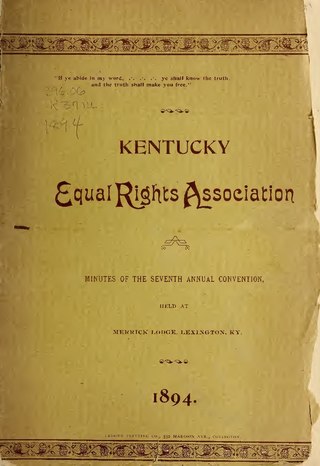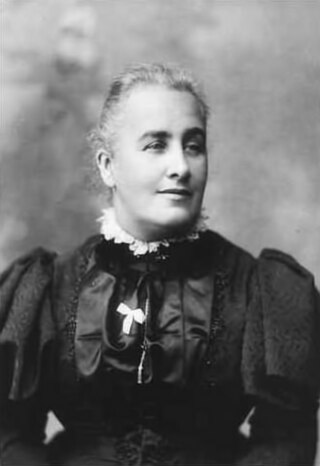Women's suffrage is the right of women to vote in elections. At the beginning of the 18th century, some people sought to change voting laws to allow women to vote. Liberal political parties would go on to grant women the right to vote, increasing the number of those parties' potential constituencies. National and international organizations formed to coordinate efforts towards women voting, especially the International Woman Suffrage Alliance.

Mary Lee was an Irish-Australian suffragist and social reformer in South Australia.

Sir John Blackler Colton, was an Australian politician, Premier of South Australia and philanthropist. His middle name, Blackler, was used only rarely, as on the birth certificate of his first son.

Women's suffrage was an important political issue in the late-nineteenth-century New Zealand. In early colonial New Zealand, as in European societies, women were excluded from any involvement in politics. Public opinion began to change in the latter half of the nineteenth century and after years of effort by women's suffrage campaigners, led by Kate Sheppard, New Zealand became the first nation in the world in which all women had the right to vote in parliamentary elections.

Kentucky Equal Rights Association (KERA) was the first permanent statewide women's rights organization in Kentucky. Founded in November 1888, the KERA voted in 1920 to transmute itself into the Kentucky League of Women Voters to continue its many and diverse progressive efforts on behalf of women's rights.

Women's suffrage in Australia was one of the early achievements of Australian democracy. Following the progressive establishment of male suffrage in the Australian colonies from the 1840s to the 1890s, an organised push for women's enfranchisement gathered momentum from the 1880s, and began to be legislated from the 1890s, decades in advance of Europe and North America. South Australian women achieved the right to vote in 1894, and to stand for office in 1895 following the world first Constitutional Amendment Act 1894. This preceded even male suffrage in Tasmania. Western Australia granted women the right to vote from 1899, although with some racial restrictions. In 1902, the newly established Australian Parliament passed the Commonwealth Franchise Act 1902, which set a uniform law enabling women to vote at federal elections and to stand for the federal parliament. By 1908, the remaining Australian states had legislated for women's suffrage for state elections. Grace Benny was elected as the first councillor in 1919, Edith Cowan the first state Parliamentarian in 1921, Dorothy Tangney the first Senator and Enid Lyons the first Member of the House of Representatives in 1943.

Robert Caldwell, occasionally referred to as "poet Caldwell", was a South Australian politician. He was a member of the South Australian House of Assembly from 1884 to 1902, representing the electorates of Yorke Peninsula (1884-1890) and Onkaparinga (1890-1902).
Sylvanus James Magarey was a surgeon and politician in the Colony of South Australia, described as "an exemplary citizen, social reformer and legislator". He was a foundation Councillor of the Women's Suffrage League.
Rosetta Jane "Rose" Birks (1856–1911) was a social reformer and philanthropist who played a key role in South Australian women's suffrage.

Elizabeth Webb Nicholls was a key suffragist in the campaign for votes for women in South Australia during the 1890s. She took on several high-profile roles in the capital of South Australia, Adelaide and was President of the Woman's Christian Temperance Union (WCTU) of South Australia, one of the most prominent organisations in the successful campaigns which made South Australia the first of the Australian colonies to grant women the right to vote in 1894.

Mary Colton, was an Australian philanthropist and suffragist.

Eliza Wigham, born Elizabeth Wigham, was a Scottish campaigner for women's suffrage, anti-slavery, peace and temperance in Edinburgh, Scotland. She was involved in several major campaigns to improve women's rights in 19th-century Britain, and has been noted as one of the leading citizens of Edinburgh. Her stepmother, Jane Smeal, was a leading activist in Glasgow and together they made the Edinburgh Ladies' Emancipation Society. Her brother John Richardson Wigham was a prominent lighthouse engineer.
The Edinburgh National Society for Women's Suffrage was a leading group for women's rights in Scotland. It was one of the first three suffrage societies to be formed in Britain.

Daisy Dorothea Solomon (1882–1978) was posted as a human letter in the British suffragette campaign using a quirk in the postal system to approach the Prime Minister who would not receive a delegation of women demanding the right to vote. Solomon was secretary to suffragette groups and imprisoned for protest, and went on hunger strike.

The Glasgow and West of Scotland Association for Women’s Suffrage was an organisation involved in campaigning for women’s suffrage, based in Glasgow, with members from all over the west of Scotland.

Women's Christian Temperance Union of New Zealand is a non-partisan, non-denominational, and non-profit organisation that is the oldest continuously active national organisation of women in New Zealand. The national organisation began in 1885 during the visit to New Zealand by Mary Clement Leavitt, the first world missionary for the Woman's Christian Temperance Union. The WCTU NZ was an early branch of the World Woman's Christian Temperance Union and a founding affiliate of the National Council of Women of New Zealand. Men may join the WCTU NZ as honorary members.

The Constitutional Amendment Act 1894 was an Act of the Parliament of South Australia to amend the South Australian Constitution Act 1856 to include women's suffrage. It was the seventh attempt to introduce voting rights for women and received widespread public support including the largest petition ever presented to the South Australian parliament. The proposed legislation was amended during debate to include the right of women to stand for parliament after an opponent miscalculated that such a provision would cause the bill to be defeated. Once passed, South Australia become the fourth state in the world to give women the vote and the first to give women the right to be elected to parliament.

Maria (Marie) Elizabeth Kirk born Maria Elizabeth Sutton was a British-born Australian temperance advocate and social reformer. She was involved in women's rights including organising a "monster" petition for women's suffrage in 1891.















